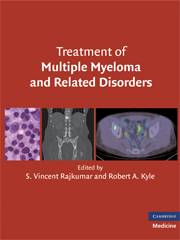Book contents
- Frontmatter
- Contents
- List of Contributors
- 1 DIAGNOSIS AND GENETIC CLASSIFICATION OF MULTIPLE MYELOMA
- 2 STAGING AND RISK-STRATIFICATION OF MULTIPLE MYELOMA
- 3 TREATMENT OF NEWLY DIAGNOSED MULTIPLE MYELOMA
- 4 MAINTENANCE THERAPY IN MULTIPLE MYELOMA
- 5 TREATMENT OF RELAPSED AND RELAPSED/REFRACTORY MULTIPLE MYELOMA
- 6 DIAGNOSIS AND TREATMENT OF MYELOMA BONE DISEASE
- 7 TREATMENT OF MYELOMA-RELATED COMPLICATIONS
- 8 AUTOLOGOUS TRANSPLANTATION FOR MULTIPLE MYELOMA
- 9 ALLOGENEIC STEM CELL TRANSPLANTATION FOR MULTIPLE MYELOMA
- 10 IMMUNOGLOBULIN LIGHT CHAIN AMYLOIDOSIS
- 11 WALDENSTRÖM MACROGLOBULINEMIA/LYMPHOPLASMACYTIC LYMPHOMA
- 12 DIAGNOSIS, RISK-STRATIFICATION, AND MANAGEMENT OF SOLITARY PLASMACYTOMA
- 13 MONOCLONAL GAMMOPATHY OF UNDETERMINED SIGNIFICANCE AND SMOLDERING MULTIPLE MYELOMA
- 14 DIAGNOSIS AND TREATMENT OF POEMS SYNDROME
- Index
- References
2 - STAGING AND RISK-STRATIFICATION OF MULTIPLE MYELOMA
Published online by Cambridge University Press: 11 July 2009
- Frontmatter
- Contents
- List of Contributors
- 1 DIAGNOSIS AND GENETIC CLASSIFICATION OF MULTIPLE MYELOMA
- 2 STAGING AND RISK-STRATIFICATION OF MULTIPLE MYELOMA
- 3 TREATMENT OF NEWLY DIAGNOSED MULTIPLE MYELOMA
- 4 MAINTENANCE THERAPY IN MULTIPLE MYELOMA
- 5 TREATMENT OF RELAPSED AND RELAPSED/REFRACTORY MULTIPLE MYELOMA
- 6 DIAGNOSIS AND TREATMENT OF MYELOMA BONE DISEASE
- 7 TREATMENT OF MYELOMA-RELATED COMPLICATIONS
- 8 AUTOLOGOUS TRANSPLANTATION FOR MULTIPLE MYELOMA
- 9 ALLOGENEIC STEM CELL TRANSPLANTATION FOR MULTIPLE MYELOMA
- 10 IMMUNOGLOBULIN LIGHT CHAIN AMYLOIDOSIS
- 11 WALDENSTRÖM MACROGLOBULINEMIA/LYMPHOPLASMACYTIC LYMPHOMA
- 12 DIAGNOSIS, RISK-STRATIFICATION, AND MANAGEMENT OF SOLITARY PLASMACYTOMA
- 13 MONOCLONAL GAMMOPATHY OF UNDETERMINED SIGNIFICANCE AND SMOLDERING MULTIPLE MYELOMA
- 14 DIAGNOSIS AND TREATMENT OF POEMS SYNDROME
- Index
- References
Summary
INTRODUCTION
Multiple myeloma is heterogeneous with respect to the genetic initiating event underpinning the development of the disease, subsequent responsiveness to chemotherapy, and, particularly, to long-term survival. As has been clinically evident over many decades, simple biochemical markers such as the myeloma isotype and the presence or absence of skeletal disease or anemia provided a rough estimate with regard to prognosis. Nevertheless, these crude tools have gradually been supplanted by more sophisticated technologies for estimating prognosis, and a time has now been reached at which routine genetically based prognostication can be performed. When appropriate testing is performed, more accurate estimations of median event-free and overall survival can be provided to the patient, probable response to transplant can be gauged, and the appropriateness of this therapy can be assessed with greater accuracy. It is important to note, however, that even with modern prognostication tools existing data are based on older therapies that have evolved substantially over the past few years such that not all genetic factors that were considered high-risk earlier this decade have maintained such high significance in the presence of more effective chemotherapy. This chapter will review both standard and genetically based prognostic markers with respect to their use and choice in prognosis prediction, in transplant response, and in choice of therapy.
PROGNOSTIC FACTORS ASSOCIATED WITH TUMOR BURDEN
The Durie-Salmon classification for many years was the most widely adopted classification system used to predict outcome for multiple myeloma patients.
- Type
- Chapter
- Information
- Treatment of Multiple Myeloma and Related Disorders , pp. 18 - 25Publisher: Cambridge University PressPrint publication year: 2008



